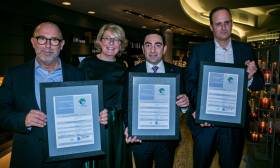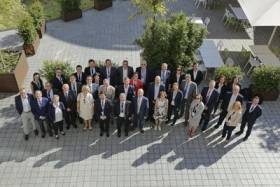Displaying items by tag: PERS
Operator Stena Line is set to create a pet-friendly area on its Belfast to Cairnryan route - but the animals must be in carrier cases onboard.
The company announced last month that pets were to be banned from passenger areas on their Irish Sea route (see rivals, P&O pets plan).
Its policy had allowed companion animals on board in secured pet carriers but after October 31, no dogs would have been allowed on deck or in any passenger areas between Belfast and Cairnryan.
However, a spokesperson for Stena Line said there has been a “considerable amount of feedback from customers on the impact of this decision to their current and future travel plans”.
“Stena Line has listened carefully to input from its passengers and the concerns that people have raised, both in support and in opposition to the proposal,” said the company.
More from Belfast Telegraph on the reversal.
Congratulations from ESPO As Ports of Barcelona, Vigo and Baku Achieve EcoPorts’ Environmental Standard (PERS)
It was congratulations from the European Sea Ports Organisation as the Port of Barcelona (Spain), Port of Vigo (Spain) and Port of Baku (Azerbaijan) achieved an EcoPorts’ environmental management standard (PERS).
Isabelle Ryckbost, ESPO’s Secretary General, handed over the PERS certificates to the ports’ representatives during the GreenPort Congress in Oslo (see related report).
“I would like to congratulate Port of Barcelona and Port of Vigo for renewing EcoPorts’ environmental standard and Port of Baku for obtaining it for the first time. Ports in Europe are more than ever investing to improve their environmental performance and to get their “licence to operate” from the local community. Transparency and sharing information with stakeholders and local communities are among the main requirements of the EcoPorts environmental standard. Being PERS certified shows that ports measure and share results. PERS ports strengthen the EcoPorts Network and help us monitoring the environmental performance of the whole sector at EU level,” says ESPO’s Secretary General, Isabelle Ryckbost.
“It is important that the number of European ports certified with an international environmental standard (EMS) has significantly increased the last five years. EcoPorts’ PERS which is the only port-specific standard available, has become well recognised and one of the most preferred by the sector. Port’s environmental performance certified by environmental standards such as PERS, is ‘factored –in’ to calculations of premiums by insurance companies and is an evidence of port’s efforts to contribute to the greening of the supply chain,” says EcoPorts coordinator, Sotiris Raptis.
Compliance with the EcoPorts’ PERS standard is independently assessed by Lloyd’s Register and the certificate has a validity of two years. EcoPorts’ PERS is revised after the 2-year period to make sure that the port continues to meet the requirements.
You can find more information on EcoPorts’ PERS here.
Irish Ports Among More than 30 Ports Certified with EcoPorts PERS Environmental Standard
#IrishPorts - Since its establishment, EcoPorts has for the first time reached the number of 32 ports certified with the environmental performance standard of the network (PERS).
Among the Port Environmental Review System (PER) certified ports, Afloat has identified two Irish ports: Dublin Port Company and Shannon Foynes Port Company.
Set up in 1997, EcoPorts operates under the European Sea Ports Organisation (ESPO) and is the main bottom-up initiative of the European ports to address the environmental challenges the sector faces.
Being PERS certified requires amongst others that the port increases transparency by making its environmental report publicly available. It also implies that the port is effectively monitoring the environmental challenges and is implementing an improved environmental management. PERS facilitates ports to comply with legislation and meet customer expectations. Additionally, ports’ environmental performance is increasingly taken into account ("factored-in") in calculations of the premium by major insurance companies; standards such as PERS are recognized as components of a sustainable approach.
“For many ports, PERS certification is the cherry on the cake, rewarding years of day-to-day engagement towards improving environmental management. We know that many other ports are meeting the requirements and are eligible for PERS certification. We hope that they will apply for the certificate. It must be seen as a quality mark for environmental sustainability. Both consumers and shippers are increasingly paying attention to a sustainable supply chain. These certificates can enhance the transparency and help them making the right choices”, says Secretary General of ESPO, Isabelle Ryckbost.
“The steady increase of the ports certified with the PERS standard, is remarkable and indicates the readiness of ports to address the environmental challenges, be transparent in communicating their environmental policy, build an even closer relationship with port cities’ communities and enhance their market reputation. We encourage all ports to join EcoPorts and obtain the PERS standard” says the EcoPorts coordinator, Sotiris Raptis.
One third of the 93 EcoPorts members have now acquired PERS, which is the only port specific environmental management standard. Compliance with the PERS standard is independently assessed by Lloyd’s Register and the certificate has a validity of 2 years. PERS is revised after the 2-year period to make sure that the port continues to meet the requirements.
The EcoPorts tools are available to ports and terminals outside Europe through the ECO Sustainable Logistic Chain Foundation (ECOSLC).

























































